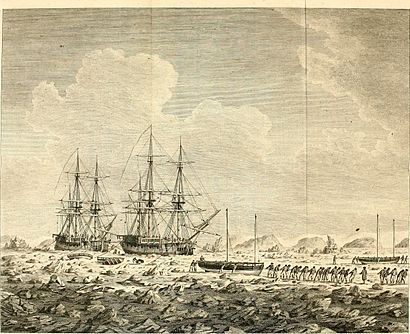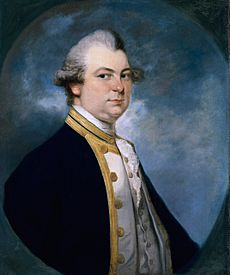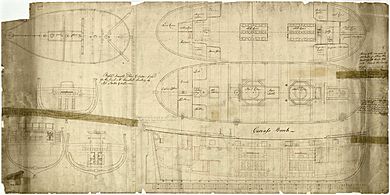1773 Phipps expedition towards the North Pole facts for kids
The 1773 Phipps expedition to the North Pole was a trip by the British Royal Navy. It was suggested by the Royal Society, a group of scientists. They believed there was an open, ice-free sea near the North Pole. Two special ships, HMS Racehorse and HMS Carcass, were made stronger to handle ice. They sailed towards the North Pole in the summer of 1773. The ships were led by Constantine John Phipps and Skeffington Lutwidge. They got stuck in the ice near Svalbard. Phipps wrote a report about the journey in 1774. This report included the first scientific descriptions of the polar bear and the ivory gull.
Contents
Why They Went North
In 1773, a scientist named Daines Barrington had an idea. He was part of the Royal Society. He thought there might be a huge, empty sea near the North Pole. He believed this sea would be free of ice. Barrington had read books by a Swiss geographer, Samuel Engel. Engel thought that most sea ice came from rivers. So, he believed ice would only be found close to land.
Barrington's idea was sent to Lord Sandwich. He was in charge of the British Navy. Lord Sandwich was friends with Barrington. He told King George III about the idea. The King liked it and said the trip should happen right away.
Getting Ready for the Trip
Constantine Phipps volunteered to lead this important trip. The Navy chose special ships called bomb vessels. These ships were built to carry heavy cannons. This meant they had very strong hulls. They were also not needed for fighting during peacetime.
The ship HMS Racehorse was chosen first. It was changed at a shipyard in March and April 1773. Another bomb vessel, HMS Carcass, was also prepared. It was commanded by Skeffington Lutwidge. Both ships got extra protection against the ice.
The Ships
The Racehorse was originally a French ship. The British Navy captured it in 1757. It had three masts and 18 guns. The ship was changed a lot for the Arctic trip. Workers added thick wood to protect against ice. They also made the front of the ship longer. Extra supports were put inside the hull.
The second ship, HMS Carcass, was built for the Royal Navy. It was also changed a lot. Parts were removed, and the hull was made double thick. More wood was added inside. This work was done very quickly, in just two days. These changes made both ships like early icebreakers.
People on Board
A total of 92 people sailed on the Racehorse. Most were Navy officers and sailors. Key members included Henry Harvey as first officer. Charles Irving was the doctor. Israel Lyons was the astronomer. Philippe d'Auvergne was a young officer. Olaudah Equiano was a skilled sailor.
The Carcass had 80 people. A young officer named Horatio Nelson was on this ship. He was not even 15 years old. He was in charge of the ship's smaller boats. Two experienced whalers from Greenland were hired for each ship. They helped guide the ships through the icy waters.
Special Gear

The ships had many new scientific tools. For finding their way, Racehorse had a Larcum Kendall K2 chronometer. Carcass had a John Arnold chronometer. These were special clocks for navigation. They also had a better chip log to measure speed. And they had Irving's machine to make fresh water from sea water. The ships carried boats big enough for everyone on board.
The Journey North
The Navy gave Phipps clear instructions. He was to sail north from the Nore. This is a sandbank in the Thames Estuary. He was told to pass between Spitzbergen and Greenland. Then, he should go as far north as possible towards the North Pole. He had to stay in the open sea. If he reached the Pole, he was to return home.
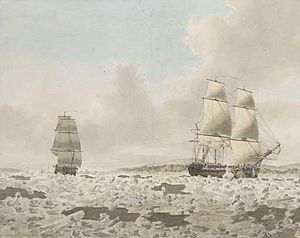
The ships left on June 4, 1773. They saw Spitsbergen on June 28. They kept sailing north, looking at the coast. From July 8, moving became very hard because of the ice. The ships had to be pulled by smaller boats. The ice to the north seemed too thick. Phipps then turned east to see if the ice was connected to Spitsbergen.
The expedition tried again to sail north. They went east along the coast, studying islands. On July 27, they reached their farthest point north. It was at 80°48'N. On July 30, Phipps and Lutwidge climbed a hill on one of the Seven Islands. They saw that the sea was completely frozen to the east. When they returned, their ships were totally surrounded by ice.
For a few days, Phipps thought they might have to leave the ships. The crew even started pulling the boats over the ice. But on August 10, the ships broke free! They got into open water. They sailed back west to Fairhaven. After one last try to sail northwest on August 19, they started their journey home. Storms separated the ships. On September 18, Carcass reached Yarmouth Roads. Lutwidge sent news of the trip to the Navy. The ships met again on September 26. They returned to the Thames on September 30.
What They Learned
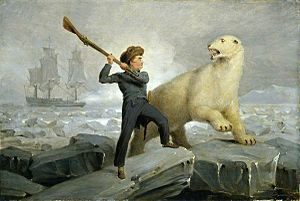
The expedition did not reach the North Pole. But this did not stop Barrington from believing it was possible. His interest then turned to the Northwest Passage. This is a sea route through the Arctic connecting the Atlantic and Pacific oceans.
The trip had important scientific results. It gave the first scientific descriptions of the polar bear and the ivory gull. Some islands in Svalbard are named after the expedition members. These include Nelsonøya, Phippsøya, and Waldenøya.
A famous story about Horatio Nelson and a polar bear began around 1800. It said Nelson chased a polar bear. When Lutwidge asked him why, Nelson supposedly said, "I wished, Sir, to get the skin for my father." After Nelson died, the story grew. It claimed Nelson tried to fight the bear with a broken musket. A painting by Richard Westall shows this scene.
A professor named Peter Fjågesund said the Phipps expedition was a turning point. It added scientific study to Arctic exploration. Before, trips were mostly about finding land and resources.


